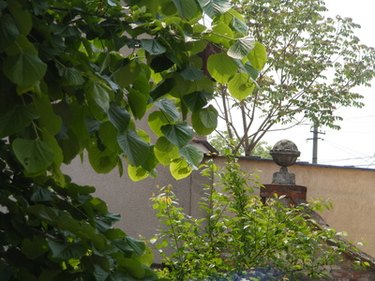Things You'll Need
Clippers
Garden shears

Well known for its long, leafy branches hanging to the ground, the popular weeping mulberry tree, or Morus alba, is deciduous. Weeping mulberries can be grown naturally or grafted onto another root. The mulberry tree needs frequent trimming to remove dead branches from its crown and to encourage new growth. A messy tangle of branches makes the tree top-heavy and susceptible to wind damage, ice or rainstorms and disease or insect problems. To keep a weeping mulberry tree tidy, developing a set of main branches and laterals, by careful, judicial, yearly trimming, is the suggested route.
Trimming Weeping Mulberry Trees
Step 1
Choose the season: Dormancy is the best time for trimming mulberry trees in late fall or early spring. In fall, trim after all the leaves have dropped. When spring arrives, trim the mulberry before new growth appears.
Video of the Day
Step 2
Choose the trimming method: The trimming method chosen depends on your purpose, whether you have a particular size in mind or you just wish to tidy the mulberry up. Trimming a weeping mulberry tree to affect size requires different trimming methods than trimming to keep it neat. Remember to always trim or prune to an upward and outward facing bud. If the mulberry is grafted, do not trim below or right on the graft site.
Step 3
Trim to affect size. To encourage a mulberry tree to grow taller, remove suckers and very low branches. Every few years, remove a few more of the lower branches. If, on the other hand, you wish to keep the mulberry compact, remove any upward growth, maintaining the height to you desire. Mulberry trees bleed when trimmed so heavy pruning is discouraged.
Step 4
Trim to tidy up. Trim any non-weeping branches. Remove any crisscrossing branches; branches rubbing together can cause injury and open the tissue to pests or disease. Cut out branches that do not have buds or possess loose bark. Providing good air circulation is integral to growing a healthy mulberry tree.
Step 5
Trim to shape. To encourage an umbrella shape, remove branches growing straight down. Trim to buds that point up and out. Keep in mind, the overall branch framework is akin to the spines of an umbrella. Keep an eye on the overall shape of the tree, keeping the crown symmetrical. Trim any lateral branches growing from the trunk. Nip off any new buds on the trunk as they appear.
Tip
Trim selectively every year, a little bit at a time, to minimize stress to the tree. Cut back lower branches gradually over a five-year period to encourage a taller tree. If the weeping mulberry tree is trimmed at the dormant stage, the bleeding will be less severe.
Warning
Cuts greater than two inches across bleed severely, do not heal very well and so should be avoided. Do not cut any branch flush with the trunk and do not seal or paint the cut as this inhibits healing. Do not prune more than twice a year. Do not remove more than one-third of the branches at any one time.
Video of the Day